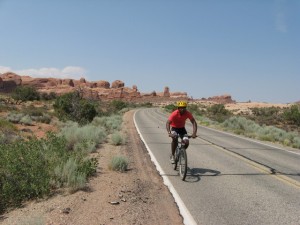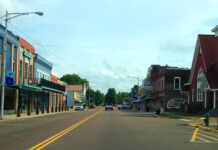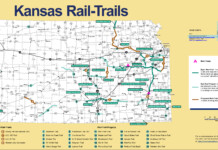
By Wayne Cottrell
The Arches Cruise is a 46-mile out-and-back ride over rolling hills in Arches National Park, including a couple of out-and-back spurs. The stunning scenery—exotic enough for an Indiana Jones film (opening sequences in Indiana Jones and the Last Crusade)—makes this a must-do ride. The route opens with a dramatic climb—and closes with a similarly dramatic descent—on switchbacks. The route is entirely on National Park roads; hence, the pavement is generally smooth. The elevation ranges from 4,097 feet at the Arches National Park Visitors Center to 5,173 feet approaching Devils Garden.
Start at Arches National Park Visitors Center. Park here and get on your bicycle. Note that there is a $10 entrance fee for motor vehicles. There is a $5 entrance fee for bicycles, so an alternative is to ride to the park from Moab, about 5 miles to the south, along US 191. Start from Swanny City Park (400 North 100 West in Moab). Note that starting from this park adds about 10 miles to the ride. There were 780,000 visitors to Arches National Park in 2005. There is no park shuttle bus, so nearly all of the visitors – except you, of course – drive the park roads.
Arches is the fourth most visited National Park in Utah, after Zion, Glen, and Bryce. The layout of the park is extremely thoughtful of the tourist who wants to see the majestic scenery but who is not particularly into hiking, climbing, rappelling, or fording his or her way to a viewpoint. The roads through Arches practically provide drive-through scenery. At only a few selected spots is it necessary to get out of the car—or off the bicycle—and walk to see what’s out there. In that sense, bicycling through Arches National Park is fun. Plenty of signs provide information about what you are seeing.
Turn right to exit the Arches National Park Visitors Center and begin a 2-mile climb, via switchbacks. At the top of the switchbacks, enjoy the panorama of the La Sal Mountains, which are to the southeast. From here, you may be challenged to keep your eyes on the road, because Arches is a smorgasbord of eye candy. Various counts estimate that there are from 1,500 to 2,000 arches within the compact 116-square-mile park. (Arches are sandstone formations that have been hollowed out through the erosive action of wind and water.) In addition to arches, there are numerous other rock formations, along with varied, tantalizing landscapes. Most of the prominent formations have names that incite the imagination. At mile 2.7 (from the park entrance), you enter the eerie landscape of “petrified dunes,” red-hued sandstone, buckled and shifted over an unstable bed of salt after exposure to wind, water, freezing, and thawing. The road is primarily downhill here.
At mile 3.7, you are surrounded by five outstanding rock formations, including The Organ, Courthouse Towers, and, a little farther up, the Tower of Babel on the right; Three Gossips and Sheep Rock are on the left. Continue descending to the crossing of Courthouse Wash, then begin to climb. Petrified dunes are on the right; rock pinnacles and The Great Wall are on the left. Balanced Rock is on the right at mile 9.0. Turn right at mile 9.2 (from the park entrance) to head toward The Windows (there are no street signs within the park). The road continues for 2.5 miles before emptying into the parking area for The Windows. Presuming that you are not planning to dismount, continue through the parking lot, around the loop, and return to the road for the return trip. Although you may not see any “Windows,” you will see Ham Rock on the right on the way in, and the Parade of Elephants on the right on the way out are on the right on the way out.
At the main road, turn right and continue toward the interior of the park. You have now covered 14.3 miles. The road descends, getting steeper at mile 15.5. Turn right at mile 17.6 to head toward Delicate Arch. This is Arches’ most photographed arch. If you do not dismount and walk the trail at the end of the 2.2-mile road, however, you will not see the arch. On the way to the Delicate Arch parking area, you will pass by Wolfe Ranch, where the Wolfe family lived from 1888 to 1910, attending to their cattle. Just beyond the ranch, on the way to Delicate Arch, is a floodwater crossing.
Return to the main road and turn right to continue into the park. You have now covered 22.3 miles. The road climbs; the arches and rock formations disappear for a while as you pass through a desert scrub landscape. Off to the right is the Fiery Furnace, an intricate maze of deep slots and narrow canyons. Spires appear on the right at mile 25.0; the road crests at mile 26.3. Skyline Arch is on the right at mile 27.2. One-half mile later, you enter Devils Garden, a truly extraterrestrial landscape. If you want to see the staggering collection of arches in this area, you must get off the bicycle and hike out. Otherwise, continue through the parking area, around the loop, and return to the main road. The return trip allows a different perspective on the memorable sights seen on the outbound trip. You will not ride any of the spurs on the return. Your inspired legs probably will not even feel as if they have just ridden 46.4 miles!
Editor’s Note: Because of the lack of shoulders on the park road, this ride is recommended for those comfortable in traffic. Consider riding early in the morning to avoid traffic. For more info, visit: http://www.nps.gov/arch/planyourvisit/biking.htm
Excerpted from Road Biking Utah (Falcon Guides), written by avid cyclist Wayne Cottrell. Road Biking Utah features descriptions of 40 road bike rides in Utah. The ride lengths range from 14 to 106 miles, and the book’s coverage is statewide: from Wendover to Vernal, and from Bear Lake to St. George to Bluff. Each ride description features information about the suggested start-finish location, length, mileposts, terrain, traffic conditions and, most importantly, sights. The text is rich in detail about each route, including history, folklore, flora, fauna and, of course, scenery.
Wayne Cottrell is a former Utah resident who conducted extensive research while living here – and even after moving – to develop the content for the book.






